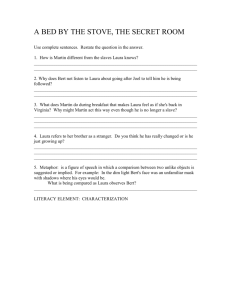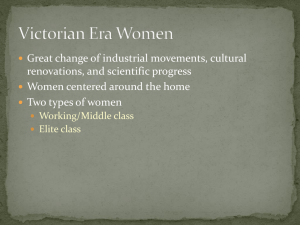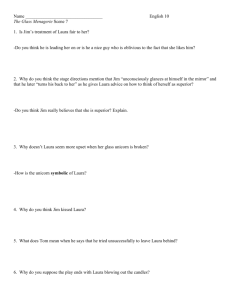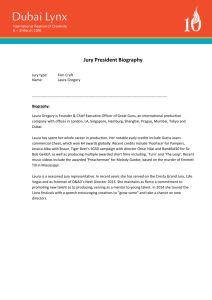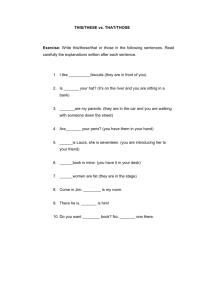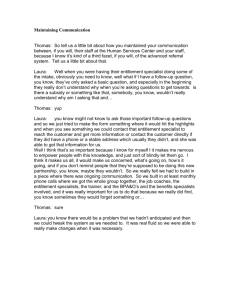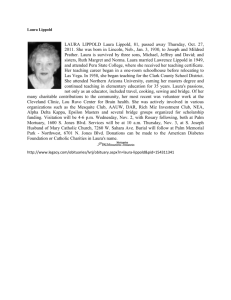1840-1900's
advertisement
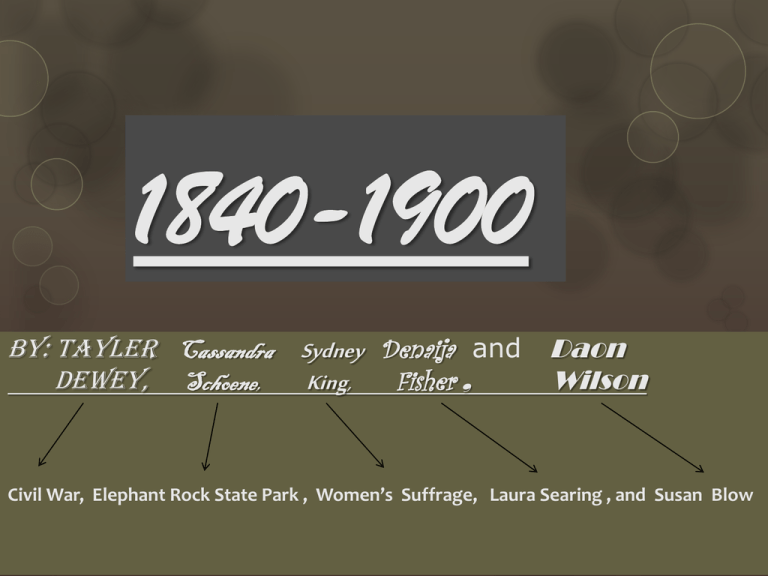
1840-1900 By: Tayler Cassandra Sydney Denaija and Dewey, Schoene, King, Fisher , Daon Wilson Civil War, Elephant Rock State Park , Women’s Suffrage, Laura Searing , and Susan Blow by Denaija Fisher Laura Redden Searing is a famous deaf poet and writer. She was born on February 9, 1839. She died on August 10, 1923. She composed the song “Belle Missouri”, which was the war song of the state of Missouri during the Civil War. Laura’s family moved to St. Louis after her father died when she was young. Laura got very sick when she was 11 and became deaf. She moved to Fulton, Missouri in 1855 to go to the Missouri School for the Deaf. After she graduated, she moved back to St. Louis and got a job as an editor of the St. Louis Presbyterian. Laura wrote articles for the St. Louis Republican, and in 1862, she was sent to Washington D.C. to write about the Civil War. While in Washington D.C, where she wrote her first book, Notable Men. She wrote a book of poems in 1864 called Idylls of Battle about the Civil War. She continued to write articles for many different newspapers. In 1865, Laura went to Europe and fell in love with Michael Brennan when she was in Italy. They got engaged, but Michael died from an aneurysm before they got married. In 1876, she married Edward Whelan Searing, a lawyer from New York. She had a daughter named Elsa in 1880, but then got divorced from Edward in 1889. In 1898, she married Roderick Marsten, but they divorced in 1904. Laura’s daughter Elsa grew up and moved to Alaska. In 1904, Elsa married John L. McGinn. They had two children named Laura and John. Laura Redden Searing moved in with Elsa’s family. It had been a long time since Laura had published her writing, and Elsa decided to help Laura. Elsa got a book of her mother’s poems and stories published in 1921. Two years later, Laura died at the age of 84. http://shs.umsystem.edu/manuscripts/inven t/2290.html http://www.columbiamissourian.com/media /multimedia/2007/pages/women/searing.ht ml http://galenet.galegroup.com/servlet/KidsIn foBits?locID=ball40762 http://web.ebscohost.com/sas/search?sid=c d92bb45-cd01-4e9d-bbdb504ea49a1813%40sessionmgr11&vid=1&hid=1 3 An American educator Born on June 7, 1843 in St. Louis. Died on March 27, 1916 in New York. She had 5 younger brothers and sisters. Someone came to her house to teach her until she was 14 and started going to school. Her family was very rich. She went to Germany and met Friedrich Froebel, who was a teacher in Germany. She decided she wanted to be a teacher after meeting him. Learned how to be a teacher in New York at the New York Normal Training Kindergarten. In 1873, she started the United States’ first public kindergarten. It was at Des Peres School in Carondelet. Her classroom was bright and colorful, had blocks and toys, and small desks for the little kids. Most classrooms were dark and gloomy, so her classroom was very different. She started teaching people how to teach kindergarten. She taught at Columbia University from 1905 – 1909. She wrote four books about how to be a kindergarten teacher. http://www.froebelfoundation.org/people/Blo w.html http://www.women-philosophers.com/SusanBlow.html http://www.historyhappenshere.org/node/6931 http://www.froebelweb.org/images/blow.html http://www.newworldencyclopedia.org/entry/ Susan_Blow The Women’s Suffrage By: Sydney King How It Started The Women's Suffrage movement started in 1848 at the Siena Falls Convention. o Susan B. Anthony spoke with a lot of important people from the government about what she thought about men getting the right to vote and not women . o Who Started It ? Susan B. Anthony and Elizabeth Cady Stanton were the first to tell the government and many other people what they thought of men having the right to vote but not women, and many other rights women didn't have. Who Was In It ? There were lots of women and very few men that had the same idea of women’s rights, like Lucy Stone and Julia Ward Stone. They may have not started it, but they did help make the associations and organizations that are still here today teaching people about women’s suffrage. What They Did A lot of the women in the suffrage movement started to protest about what they thought was right or wrong. Some women started to hold marches and protested by holding up posters in front of different places. Men had to vote to allow women to vote. When It Ended? The women's suffrage movement ended in the year of 1920 when the 19th amendment was passed. After long years of protest, they finally won. Now women have had their fair say in everything when it comes to politics. Fun Facts Did you know that Susan B. Anthony dressed up like a man so she could vote? She was caught and put in jail, then refused to pay the $100 fine, but in the end she ended up voting anyway . Did you know that Woman's Suffrage was 72 years long!!!!! In 1915, only eleven states let women vote. Work Cited www.Scholastic.com www.NAWSA.com www.HultonArchive.com www.wikipedia.org WAR • The Civil War was fought in 10,000 different places. Over 600,000 men died in it. • They fought big battles miles away from their home. • They first found themselves only 20 miles from their own front door once they were in the army. • If you lived in the South during the war you lost a lot of family members. • The Civil War has many names, for example: The War Between the States. • The men knew they were making history and were proud to risk their lives for that. WEAPONS • They had Iron Clad ships, Gatling guns, Observation Balloons, Repeating Rifles, and submarines. • They used old guns and made them better in the war. It helped them win the war, because eventually we did! THE BATTLES • The battles of the Civil War were one of the most important things in the U.S. • It was also one of the most violent scariest wars. • After the war in Fredericksburg it was a disaster all the houses were torn in half. ROBERT E. LEE • Robert E. Lee was born on Jan.19,1807 and was the general of the Confederates (south). • He was the fifth child , his dad is Henry Lee , on June 30, 1831 he married Mary Anne Randolph Custis . ULYSSES S. GRANT • Ulysses S. Grant lived in St. Louis and had a farm that is famous. • You can explore and learn about him . • In the Civil War Ulysses S. Grant didn’t give up and he’s part of the reason we won. • He was also the general that lead the Union (north). WORK CITED • http://en.wikipedia.org/wiki/Robert_E._Lee • http://en.wikipedia.org/wiki/Ulysses_S._Grant • http://www.civilwar.com/ • http://galenet.galegroup.com/servlet/KidsInfoBits?subTopic=U.S.%2BHistory&lo cID=ball40762&failover=0&topic=History%252C%2BGovernment%2B%2526%2B Social%2BStudies&c=1&searchTerm=United%2BStates%2BCivil%2BWar%252C% 2B1861-1865&ste=5&tbst=tsrch&tab=1&bConts=39 History of the Rocks The stars of Elephant Rock State Park 1.5 billion years ago hot magma formed boulders… 250 million years ago the cracks fell off the boulders… It got it’s name… History on the Quarries 19th century quarries... Pink granite blocks… Entertainment Picnicking, hiking, climbing, and biking… Bird watching, fishing, and tours… A great place for families… Trails Handicapped useable Trail… Non-handicapped Trails… Interesting Facts Dumbo the rock… Nearby Town… Governor's Mansion… Algae Lichen… Work Cited http://mostateparks.com/park/elephant-rocks-state-park http://www.google.com/search?q=%22History+of+Elephant+Rock+State+Pa rk%22&hl=en&lr=&safe=active&prmd=imvns&source=lnms&tbm=isch&ei=F ylyT_XnD8rUgAe3bhb&sa=X&oi=mode_link&ct=mode&cd=2&ved=0CBQQ_AUoAQ&biw=136 6&bih=600 http://commons.wikimedia.org/wiki/File:Elephant_rock_state_park_(5089834 607).jpg http://www.stateparks.com/elephant_rocks_state_park_in_missouri.html http://en.wikipedia.org/wiki/Elephant_Rocks_State_Park http://www.rollanet.org/~conorw/cwome/05_12-18-2005_elephant_rocks.jpg http://www.missouri-vacations.com/elephant-rocks-state-park/ http://www.mountainproject.com/v/elephant-rocks-state-park/106328972
